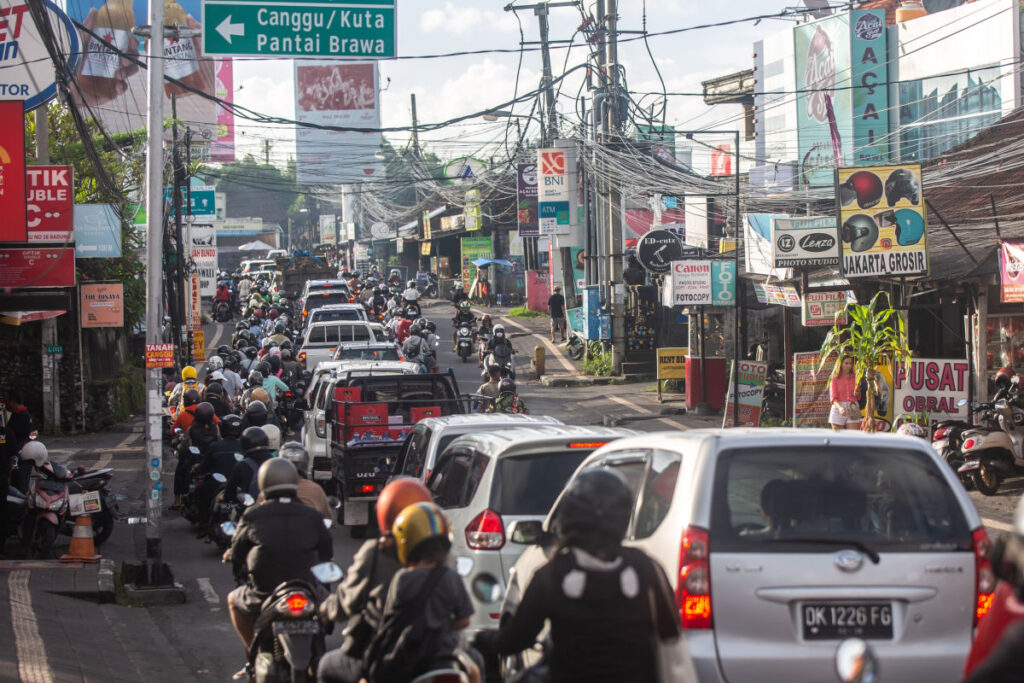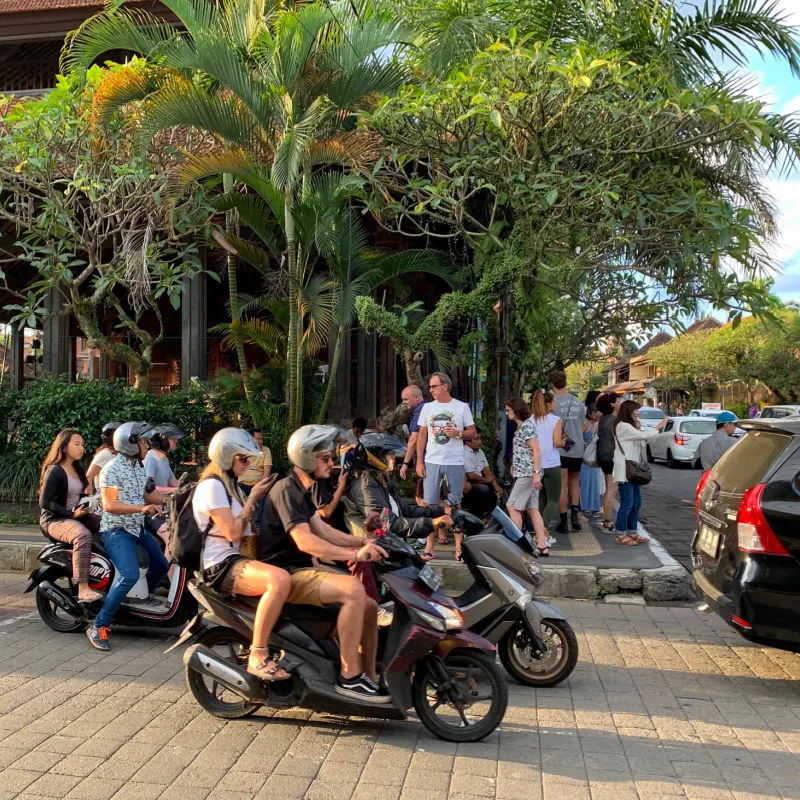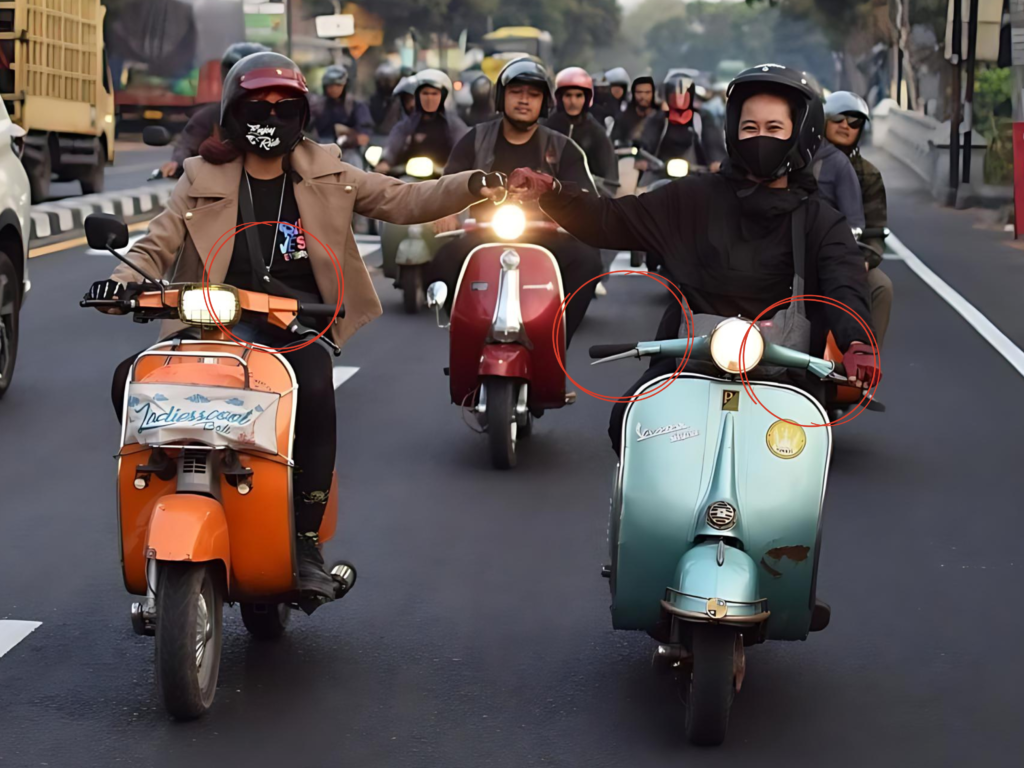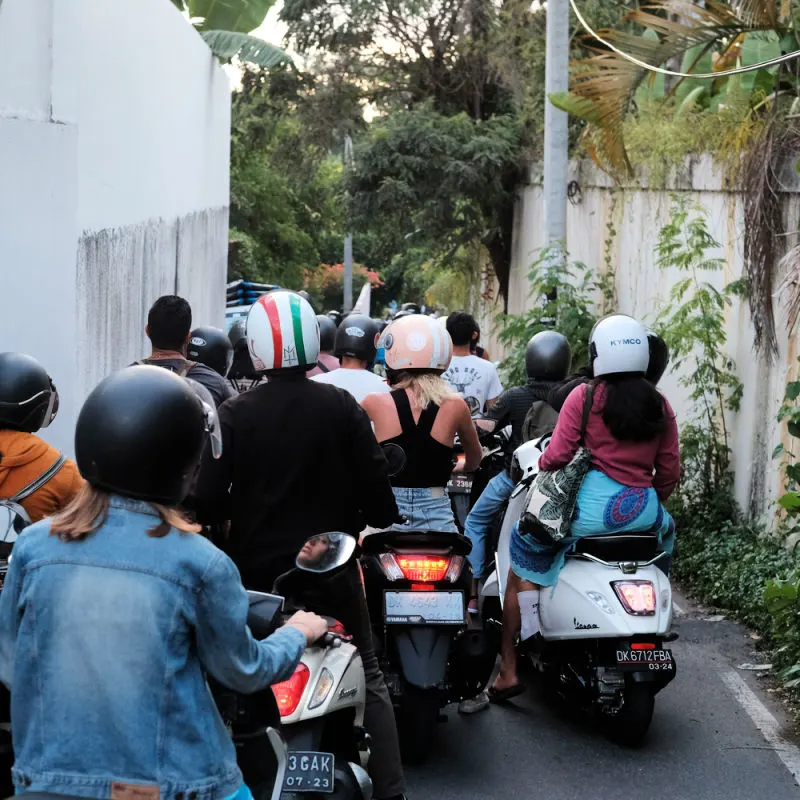Navigating through travel endeavours can prove challenging, encompassing tasks from scheduling to budgeting.
Every detail becomes even more daunting when attempting to squeeze multiple destinations into a single day.
Taxi fares are expensive, and public transportation remains unreliable, consuming much of your valuable time.
For individuals possessing an International Driver’s License or having secured an Indonesian Driver’s License (SIM) from the local DMV (Samsat), renting a vehicle emerges as the optimal solution.
Whether opting for a motorcycle or a car, having your personal vehicle promises substantial budget savings.

However, it must be underscored that driving in Bali presents unique challenges unlike any other locale on Earth.
Every individual who has sojourned on this island for an extended duration bears witness to their own array of remarkable driving anecdotes.
The driving experience here bewilders even Indonesians hailing from other provinces.
While many foreign visitors possess the theoretical acumen to operate a vehicle, their practical execution often falters due to recklessness or inexperience.
And the native islanders aren’t in any way better, despite commencing their driving endeavours at a very tender age,-
-they often lack familiarity with traffic regulations, owing to inadequate guidance and enforcement by local authorities.

Illegitimate acquisition of licences through illicit means remains prevalent, further exacerbating the situation.
According to data from the Bali Province Central Statistics Agency (bali.bps.go.id), there have been 13,071 recorded traffic accidents in Bali Province from 2021 to 2023, resulting in 1,094 fatalities.
To mitigate such risks, Tabebuia’s editorial team has compiled a list of eight common driving behaviours encountered in Bali.
1. Driving Below the Speed Limit
Bali’s captivating landscapes and rich culture attract visitors worldwide. However, navigating the island by a personal vehicle can be a frustrating experience due to a confluence of factors.
Believe it or not, driving below the speed limit is a major problem in this island especially for car drivers as they take much more space than motorcycles.

Unlike bustling city centres with wide avenues, Bali’s infrastructure, outside of major tourist and business hubs, hasn’t kept pace with the surge in vehicles.
While most roads have been paved with concrete or asphalt, their width remains largely unchanged from centuries past, when buffalo carts and rickshaws were the primary mode of transport.
Resulting in many of the roads being significantly narrow compared to the amount of vehicles that this island has.
Compounding the issue are the driving habits prevalent on these narrow roads. Majority of the local drivers, especially unlicensed taxi drivers soliciting fares and tourists unfamiliar with the terrain, tend to travel at exceptionally slow speeds.
This behaviour, often exacerbated by drivers distracted by their phones, and/or hunting for customers to scam, can quickly lead to kilometres-long traffic jams, particularly in dense areas like Ubud and Canggu.

It’s important to note that Indonesia has established regulations to address speed limits. Law of the Republic of Indonesia Number 22 of 2009 about Traffic and Road Transport –
– sets the minimum and maximum permissible speeds for motorised vehicles based on road classification.
Furthermore, Regulation Number PM 111 of 2015, issued by the Minister of Transportation, outlines specific procedures for determining and displaying speed limits through traffic signage, namely;
- the lowest is 60 (sixty) kilometres per hour in free flow conditions
- maximum 100 (one hundred) kilometres per hour for freeways
- maximum 80 (eighty) kilometres per hour for inter-city roads
- maximum 50 (fifty) kilometres per hour for urban areas
- maximum 30 (thirty) kilometres per hour for residential areas
In essence, while regulations exist, enforcing them and encouraging more considerate driving practices are crucial steps in alleviating Bali’s traffic congestion woes.
2. Overtaking Manoeuvres in Tight Spaces: A Recipe for Gridlock
On these narrow roads of Bali, common sense would dictate careful planning and strategic execution for any overtaking manoeuvre. However, Balinese driving practices can defy logic.
Drivers, primarily native islanders, determined to overtake even a small motorbike, will often swerve into oncoming traffic, creating dangerous situations.

If you’re approaching from the opposite direction, be extremely cautious and anticipate these unpredictable manoeuvres.
3. The Disappearing Blinker: A Communication Breakdown
One might assume that turn signals, a fundamental component of any vehicle, would be a ubiquitous feature on Bali’s roads.
However, this is often not the case. Many local drivers seem entirely unfamiliar with the concept of using blinkers to indicate lane changes or turns.
For motorcyclists, anticipating manoeuvres might involve deciphering body language. For car drivers, maintaining a safe distance becomes an essential defensive driving tactic.

4. The Blind Spot: A Looming Threat
Bali’s reputation for spiritualism and magic extends, perhaps tongue-in-cheek to its roads.
Here, drivers of all ages and genders frequently navigate without utilising their rearview mirrors when turning or changing lanes.
While some might believe this disregard stems from mystical forces and sorcery possessed by the locals, the reality is more likely a lack of safe driving knowledge and habits.
In even more concerning instances, some drivers have even removed their mirrors entirely, prioritising aesthetics over safety.
This behaviour creates significant blind spots, posing a serious threat to themselves and other road users.

5. Mastering the Lanes (or Not): A Chaotic Dance
Bali adheres to left-hand side traffic, a standard practice in Indonesia. Normally when you drive anywhere else in the world, it is the most basic knowledge to drive slowly on one side and let other vehicles overtake you from the other side.
However, this seemingly basic rule seems to become negotiable on Balinese roads. Drivers of all types of vehicles, from motorcycles, cars to trucks and buses, navigate wherever they please, seemingly oblivious to lane markings.
This disregard for lane discipline creates a chaotic dance on the road, making overtaking and passing manoeuvres unpredictable and potentially dangerous.

6. The Charm of the Centreline: A Nocturnal Nuisance
One might believe that nighttime driving offers a respite from the daytime traffic chaos. However, this isn’t necessarily the case in Bali.
Even with less traffic on the roads, many local drivers, particularly those in cars, gravitate towards the centre lane, driving in the middle and often on top of the lane markings, regardless of oncoming traffic.
If they are adhering to the speed limit, it might create a somewhat tolerable experience behind them, the reality is these drivers often travel below the limit.
Unfortunately, in these situations, there’s little recourse for frustrated drivers stuck behind them, as flashing headlights or honking excessively proves futile.
The only option becomes waiting for a rare opportunity to overtake on a wider stretch of road.

7. Stopping Without Warning: A Recipe for Gridlock
There are significantly more unlicensed taxi drivers in Bali than the licensed and regulated ones and every single one of them are lacking proper training, disregard traffic laws and safe driving practices.
Being illegal and untrained, standard operational procedures of being a taxi driver are unbeknownst to them.
One particularly disruptive behaviour involves stopping abruptly in the middle of the road to pick up or drop off passengers, with little regard for the flow of traffic and no effort whatsoever to move to the side of the road.
This inconsiderate action, sometimes lasting for several minutes, can cause significant congestion.
Miraculously, surrounding local bystanders always seem unfazed by these sudden stoppages, contributing to the overall chaotic driving environment.

8. Parking Perils: The Wild West of Roadside Manners
Just when you think you’ve escaped the traffic mayhem upon reaching your destination, think again.
Many places in Bali lack designated parking attendants, and local drivers often exhibit a casual disregard for proper parking etiquette.
Even in designated parking areas such as strip malls or minimarts with marked spaces, following the lines seems like an optional suggestion.
This haphazard parking can create a domino effect, as vehicles squeeze into any available space, potentially blocking others.
To avoid getting stuck, prioritise parking areas with attendants or opt for spots closer to exits, allowing for a quicker getaway.
As a last resort, consider parking with your vehicle facing outwards for easier manoeuvring when leaving.

Although even this wouldn’t necessarily be an optimal solution as they would park horizontally by the roadside, often even entirely blocking the traffic.
These behaviours merely scratch the surface of Bali’s idiosyncratic driving culture. Newcomers navigating the island’s roads for the first time can expect a significant learning curve.
And to make matters worse, the native islanders are completely oblivious to what they are doing wrong due to the lack of knowledge, thus there is nothing we can say to make them better.
Unlicensed taxi drivers, unpredictable lane changes, inconsiderate stopping habits, and many more contribute to the island’s traffic woes.
However, with the right approach, navigating Bali’s roads can still be a manageable experience.

Tips for a Smoother Ride
- Car Drivers : Exercise extreme caution, anticipate unexpected manoeuvres, and prioritise defensive driving tactics. Familiarise yourself with Indonesian traffic laws beforehand.
- Scooter Riders : While offering greater agility in traffic, ensure you have a valid licence and international insurance. Always prioritise safety and wear a helmet.
- Pedestrians : Utilise designated crosswalks whenever possible, walk on the side against the oncoming traffic to be able to see what’s coming to you and maintain a heightened awareness of your surroundings.
For those of you that aren’t discouraged to drive in Bali after reading this article or simply curious to experience it yourself, the best we can do is to anticipate what they will do before they do it,-
– and be a good example to them by avoiding to do the same thing while being obedient to Indonesian traffic laws.
While Bali’s traffic presents a challenge, by following these tips and remaining patient, you can navigate Bali’s roads and focus on enjoying your island adventure.





